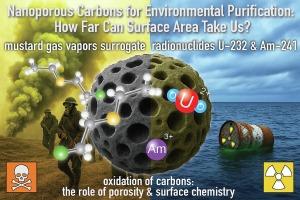Ultrahigh surface area nanoporous carbon for air and water purification: Pushing the boundaries and unveiling the key physicochemical features
IF 13.2
1区 工程技术
Q1 ENGINEERING, CHEMICAL
引用次数: 0
Abstract
Nanoporous carbons are widely employed in environmental remediation applications due to their high surface area, tunable porosity, and adaptable surface chemistry. In this study, three commercial activated carbons, MSC, CPL, and SXP, were intentionally and precisely selected to span a broad range of surface areas (~1000–3000 m2/g) and surface pH values (5.3–7.5), enabling a comparative evaluation of their physicochemical properties and adsorptive performance. These materials and their oxidized counterparts were tested against hazardous vapors (blister agent mustard gas surrogate, CEES) and aqueous pollutants (radionuclides U-232 and Am-241). MSC exhibited an ultrahigh surface area and delivered the highest CEES uptake (1397 mg/g), the highest reported to date. However, oxidation significantly decreased porosity, resulting in diminished vapor-phase performance. In contrast, the same oxidation enriched the surfaces with acidic oxygen-containing functional groups, substantially enhancing radionuclide affinity, especially in neutral and saline media. The oxidized MSC outperformed all other materials in aqueous radionuclide removal, across a wide range of pH (4–9) and more importantly, in seawater. These results reveal the dual role of oxidation: beneficial for liquid-phase adsorption through surface complexation, yet unfavorable for gas-phase purification where pores volume and accessibility maters the most. Overall, this work underscores the importance of tuning both surface area and surface chemistry for application-specific purification strategies and finally that activated nanoporous carbons can push even further the boundaries for efficient air and aqueous purification applications.

用于空气和水净化的超高表面积纳米多孔碳:突破界限,揭示关键的物理化学特征
纳米多孔碳因其高表面积、孔隙度可调和表面化学适应性强而广泛应用于环境修复中。在这项研究中,三种商业活性炭,MSC, CPL和SXP,被有意和精确地选择,跨越广泛的表面积(~ 1000-3000 m2/g)和表面pH值(5.3-7.5),使其物理化学性质和吸附性能的比较评估。对这些材料及其氧化对应物进行了有害蒸气(起泡剂芥子气替代物,CEES)和水性污染物(放射性核素U-232和Am-241)的测试。MSC表现出超高的表面积,并提供最高的CEES摄取(1397 mg/g),这是迄今为止报道的最高水平。然而,氧化显著降低了孔隙度,导致气相性能下降。相反,同样的氧化使表面富含酸性含氧官能团,大大增强了放射性核素的亲和力,特别是在中性和盐水介质中。氧化的MSC在水中去除放射性核素的性能优于所有其他材料,在很大的pH范围内(4-9),更重要的是,在海水中。这些结果揭示了氧化的双重作用:有利于通过表面络合进行液相吸附,但不利于气孔体积和可及性最重要的气相净化。总的来说,这项工作强调了调整表面积和表面化学对特定应用净化策略的重要性,最后,活化纳米多孔碳可以进一步推动高效空气和水净化应用的边界。
本文章由计算机程序翻译,如有差异,请以英文原文为准。
求助全文
约1分钟内获得全文
求助全文
来源期刊

Chemical Engineering Journal
工程技术-工程:化工
CiteScore
21.70
自引率
9.30%
发文量
6781
审稿时长
2.4 months
期刊介绍:
The Chemical Engineering Journal is an international research journal that invites contributions of original and novel fundamental research. It aims to provide an international platform for presenting original fundamental research, interpretative reviews, and discussions on new developments in chemical engineering. The journal welcomes papers that describe novel theory and its practical application, as well as those that demonstrate the transfer of techniques from other disciplines. It also welcomes reports on carefully conducted experimental work that is soundly interpreted. The main focus of the journal is on original and rigorous research results that have broad significance. The Catalysis section within the Chemical Engineering Journal focuses specifically on Experimental and Theoretical studies in the fields of heterogeneous catalysis, molecular catalysis, and biocatalysis. These studies have industrial impact on various sectors such as chemicals, energy, materials, foods, healthcare, and environmental protection.
 求助内容:
求助内容: 应助结果提醒方式:
应助结果提醒方式:


